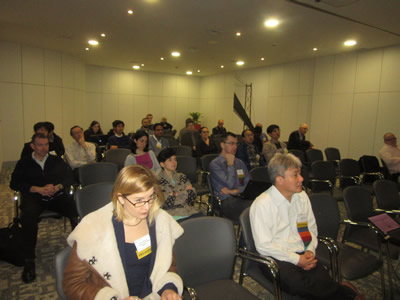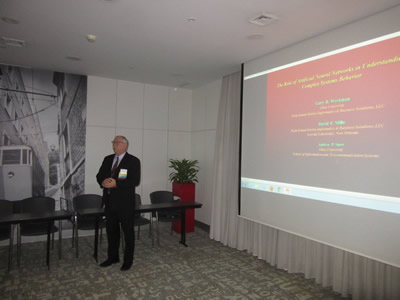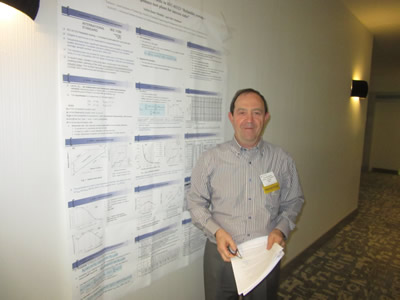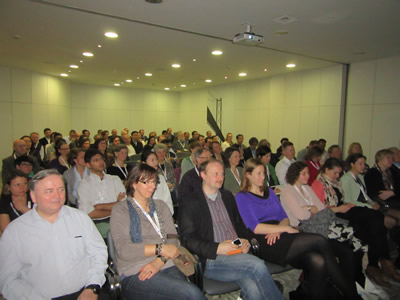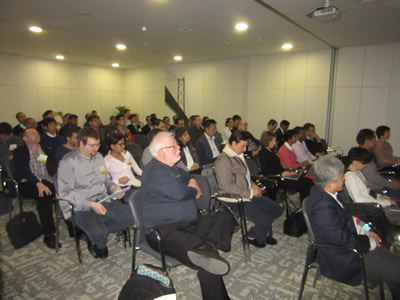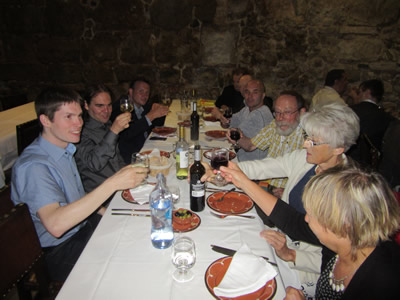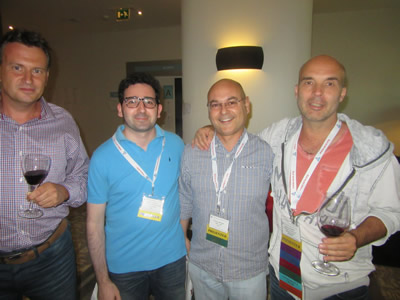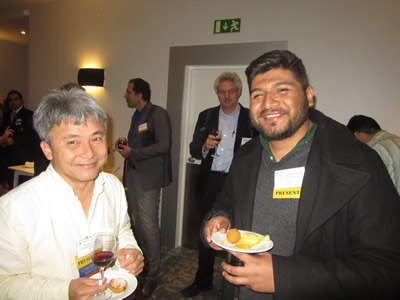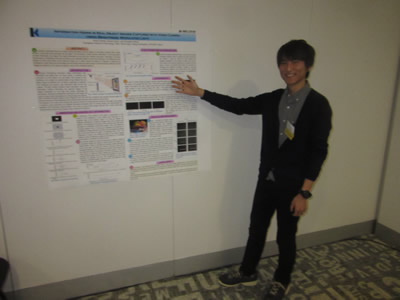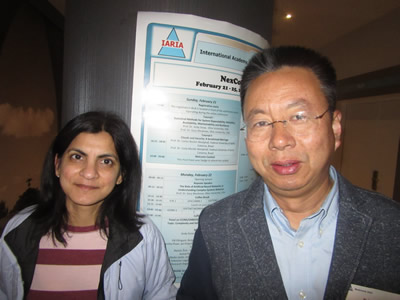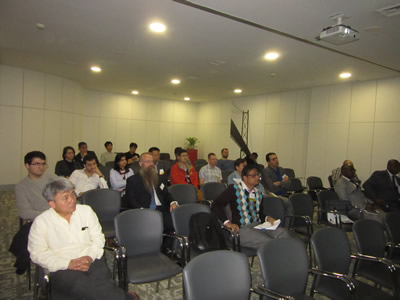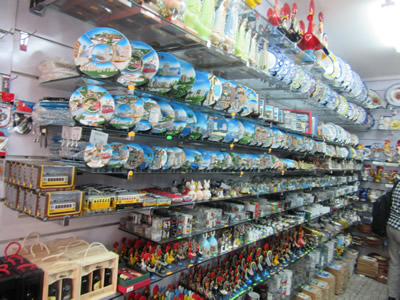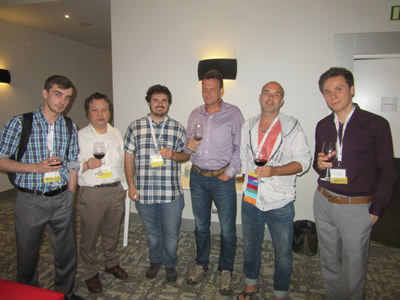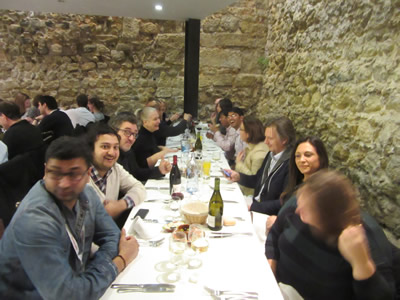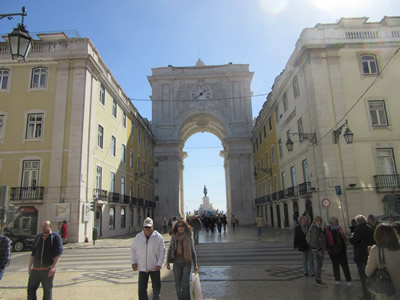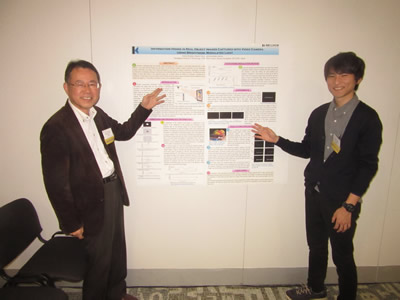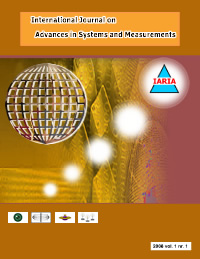SENSORCOMM 2022 - The Sixteenth International Conference on Sensor Technologies and Applications
October 16, 2022 - October 20, 2022
SENSORCOMM 2022: Call for Papers
Onsite and Online Options: In order to accommodate a large number of situations, we are offering the option for either physical presence or virtual participation (pdf slides or pre-recorded videos).
SENSORCOMM 2022 (The Sixteenth International Conference on Sensor Technologies and Applications) is a multi-track event covering related topics on theory and practice on wired and wireless sensors and sensor networks.
Sensors and sensor networks have become a highly active research area because of their potential of providing diverse services to broad range of applications, not only on science and engineering, but equally importantly on issues related to critical infrastructure protection and security, health care, the environment, energy, food safety, and the potential impact on the quality of all areas of life.
Sensor networks and sensor-based systems support many applications today on the ground. Underwater operations and applications are quite limited by comparison. Most applications refer to remotely controlled submersibles and wide-area data collection systems at a coarse granularity.
Underwater sensor networks have many potential applications such a seismic imaging of undersea oilfields as a representative application. Oceanographic research is also based on the advances in underwater data collection systems.
There are specific technical aspects to realize underwater applications which can not be borrowed from the ground-based sensors net research. Radio is not suitable for underwater systems because of extremely limited propagation. Acoustic telemetry could be used in underwater communication; however off-the-shelf acoustic modems are not recommended for underwater sensor networks with hundreds of nodes because they were designed for long-range and expensive. As the speed of light (radio) is five orders of magnitude higher than the speed of sound, there are fundamental implications of time synchronization and propagation delays for localization. Additionally, existing communication protocols are not designed to deal with long sleep times and they can't shut down and quickly restart.
In wireless sensor and micro-sensor networks energy consumption is a key factor for the sensor lifetime and accuracy of information. Protocols and mechanisms have been proposed for energy optimization considering various communication factors and types of applications. Conserving energy and optimizing energy consumption are challenges in wireless sensor networks, requiring energy-adaptive protocols, self-organization, and balanced forwarding mechanisms.
As a multi-track event, SENSORCOMM 2022 will serve as a forum for researchers from the academia and the industry, professionals, standard developers, policy makers and practitioners to exchange ideas. The topics could be on techniques and applications, best practices, awareness and experiences as well as future trends and needs (both in research and practices) related to all aspects of information security, security systems and technologies.
The conference has the following independents tracks:
- TRENDS: Targets and achievements
- APASN: Architectures, protocols and algorithms of sensor networks
- MECSN: Energy, management and control of sensor networks
- RASQOFT: Resource allocation, services, QoS and fault tolerance in sensor networks
- PESMOSN: Performance, simulation and modelling of sensor networks
- SEMOSN: Security and monitoring of sensor networks
- SECSED: Sensor circuits and sensor devices
- RIWISN: Radio issues in wireless sensor networks
- SAPSN: Software, applications and programming of sensor networks
- DAIPSN: Data allocation and information in sensor networks
- DISN: Deployments and implementations of sensor networks
- AIS: Atmospheric Icing and Sensing
- UNWAT: Under water sensors and systems
- ENOPT: Energy optimization in wireless sensor networks
We solicit both academic, research, and industrial contributions. We welcome technical papers presenting research and practical results, position papers addressing the pros and cons of specific proposals, such as those being discussed in the standard fora or in industry consortia, survey papers addressing the key problems and solutions on any of the above topics short papers on work in progress, and panel proposals.
Industrial presentations are not subject to the format and content constraints of regular submissions. We expect short and long presentations that express industrial position and status.
Tutorials on specific related topics and panels on challenging areas are encouraged.
The topics suggested by the conference can be discussed in term of concepts, state of the art, research, standards, implementations, running experiments, applications, and industrial case studies. Authors are invited to submit complete unpublished papers, which are not under review in any other conference or journal in the following, but not limited to, topic areas.
All topics and submission formats are open to both research and industry contributions.
SENSORCOMM 2022 conference tracks:
TRENDS: Targets and achievements
Low-power sensor networks; Energy harvesters; Universal access; Smart metering; Medical sensor networks; Sensing sensor signals; Intrabody communication channels; Human sensor networks; Local aggregation IoT (Internet of Things); Social swarming information; Sensor-actuator networks; Sensing real-time networks; Environmental sensor networks; Indoor and outdoor sensor networks; Urban wireless sensor networks; Wearable smart sensor networks; Human emotions/activities recognition; Antenna and feature selection; Open source and open hardware devices; Measurement apps; Resiliency and specialized protocols; Synchronization in wireless sensor networks; Propagation-aware synchronization; Tracking and partial position information; Failure handling; Security and authentication
APASN: Architectures, protocols and algorithms of sensor networks
Network planning, provisioning and deployment; Network Architectures for Sensor Networks; Network Protocols for Sensor Networks; Structural design; Distributed Sensor Networks; Dynamic sensor networks; Scalable and heterogeneous architectures; Hierarchical clustering architectures; Group-based Architectures; Network topologies; Mesh networking; Device centric sensor networks; Distributed coordination algorithms; Topology construction; Routing protocols; Routing Metrics; Distributed Algorithms; Attribute-based named nets; Mobility and Scalability; Attribute-based named Sensor Networks; Query optimization; Self-organization and self-configuration algorithms; Reconfigurability; Time Synchronization; MAC protocols for sensor networks (801.11, 802.15.4, UWB, etc); Location and time service; Integration with other systems; Distributed inference and fusion; Cross-layer design and optimization; Complexity analysis of algorithms; Sensor networks and the Web; Integration with other systems (e.g., Web-based information systems, process control, enterprise software, etc.); Target tracking; RFID tags; Traffic scheduling
MECSN: Energy, management and control of sensor networks
Energy models; Energy optimization; Energy management; Power-aware and energy-efficient design; Power sources in sensor networks; Battery technology; Power management; Algorithms and theories for management; Communication strategies for topology control; Algorithms and theories for supervisory control; Sensor tasking and control; Distributed control and actuation; Location and mobility management; Bandwidth management; Distributed networked sensing; Resource provisioning; Resource management and dynamic resource management; Schemes to maximize accuracy and minimize false alarms; Online self-calibration and self-testing; Handoff and mobility management and seamless internetworking; Distributed actuation and control; Topology control
RASQOFT: Resource allocation, services, QoS and fault tolerance in sensor networks
Algorithms to support quality of service in sensor networks; Protocols to support quality of service in sensor networks; QoS/SLA in sensor networks; Provisioning of QoS in terms of bandwidth and delay assurance; System services and distributed services in sensor networks; Delay tolerant networks and opportunistic networking; Failure resilience and fault isolation; Information assurance in sensor networks; Fault tolerance and reliability; Admission control; Resource allocation and fairness; Real-time resource scheduling; Scheduling and optimisation; Capacity planning
PESMOSN: Performance, simulation and modelling of sensor networks
Performance measurement of sensor networks; Performance evaluation and analysis of sensor networks; Performance comparison on capacity, coverage and connectivity; Modelling techniques of sensor networks; Validation of sensor network architectures; Simulation and theoretical analysis; Simulation software tools and environments; Theoretical performance analysis: complexity, correctness and scalability; Design, simulation and optimization tools for deployment and operation; Platform modelling and analysis tools; Analytical, mobility and validation models; System debugging and testing
SEMOSN: Security and monitoring of sensor networks
Security and privacy in sensor networks; Reliability aspects in sensor networks; Monitoring distributed sensor networks; Mechanisms for authentication; Secure communication in sensor networks; Encryption algorithms for sensor networks; Sensor secure management; Data integrity; Trustworthiness issues in sensor networks; Trade-off analysis
SECSED: Sensor circuits and sensor devices
Methods for sensor deployment; Instrumentation and models for deployment of sensors networks; Sensor architecture; Abstractions for modular design; Design and deployment of embedded system platforms; Embedded architectures and tools; Embedded processors; Embedded chip design; Micro and Nano devices; Biosensors; Optical sensors; Smart sensors; Acoustic Sensors; Microwave sensors; Middleware design; Sensor Prototypes; Sensor node components; Sensor interfaces; Actuators; Independent Component Analysis; Design of cost effective and economical sensors; Smart Material Applications to design sensors; Microfabrication Technologies for Microsystem Integration; Integration of sensors into engineered systems; Hardware platforms; Test-beds incorporating multiple sensors; Operating system and middleware support
SOCIAL: Social Sensing
Social computing; Mobile phones as social sensors (Mobile sensing); Wearable sensing; Spatial epidemiology; Data availability and quality; Dataprotection and confidentiality, Social mining; Reality mining; Mobility patterns; Sampling and computation distribution; Human information processing; Battery power and communication tradeoff; Sensing systems tools; Applications and experiences; Social sensing applications; Complex social systems; Compressed sensing.
RIWISN: Radio issues in wireless sensor networks
Wireless Sensor Communications; Network connectivity & longevity; Tracking objects; Geo-location problems; Network coverage; Algorithms for sensor localization and tracking; Detection, classification and estimation; Physical layer impact on higher level protocols; Directional and smart antennas for sensor networks; Coverage maintenance; Transceiver and antenna design; Ubiquitous wireless connectivity
SAPSN: Software, applications and programming of sensor networks
Applications and demonstrations of sensor networks; Software platforms and development tools; Architectural design and optimization tools for sensor nodes; Computation and programming models of sensor networks; Languages and operating systems of Sensors; Programming and Interfacing; Programming abstraction; Programming models for sensors; Programming methodology for sensor environments; Intelligent sensor theory and applications; Machine learning applications to sensor networks; Wireless sensor applications; Applications for sensor network management; Software tools for chip programming; Application requirements; Application evaluation and comparison; Demos and prototype testing
DAIPSN: Data allocation and information in sensor networks
Techniques for the interpretation and use of sensor data in decision-making processes; Distributed data processing; Distributed signal processing; Array signal processing; Statistical signal processing; Distributed query processing; Distributed information processing; Distributed algorithms for collaborative information and signal processing; Task allocation, reprogramming and reconfiguration; Coding and information theory; In-network processing and aggregation; Data analysis and visualisation; Data storage in sensor networks; Data retrieval; Data dissemination; Data compression and aggregation; Data transport in wireless sensor networks; Data gathering and fusion in wireless sensor networks; Theories and models on fundamental information and communication aspects of sensor networks; Redundancy
DISN: Deployments and implementations of sensor networks
Methods for sensor networks deployment; Practical implementations and real-world experiences; Real-life deployments; System implementation; End-user aspects; Operational experience and test-beds; Industrial and commercial developments and applications; Measurements from experimental systems, test-beds and demonstrations; Intelligent sensors, body sensors and their utilisation; Analysis of real-world systems and fundamental limits; Smart Sensors for building surveillance; Sensing in health care; Games using sensor networks; Peer-to-peer, overlay, and content distribution wireless sensor networks; Use cases (e.g., Automotive, Battlefield, Defense, Construction, Disaster recovery, Environmental, Medical, Security, Biomedical, Unmanned Aerial Vehicles, etc.); Sensor networks for Rural and Agricultural environments; Sensors for railway systems; Pattern Recognition; Machine Intelligence; Sensor-equipped Smart Environment; Deployments in Harsh Environments; Potential application areas
AIS: Atmospheric Icing and Sensing
Design aspects of atmospheric ice sensor (Control circuitry, winterization, power supporting system, embedded systems, power converters, interface and data links, communication, material ,quality control, practical implementations, real time development, end user aspects); Atmospheric ice sensing techniques (Capacitive ice sensors, infrared ice sensors, load cell based ice sensors, vibrating probe based ice sensor, ultrasonic ice sensors); Applications of atmospheric ice sensor (Ice sensors for wind energy/resource assessment, ice sensors for offshore structures, ice sensors for road applications, ice sensors for power transmission, ice sensors for aviation, ice sensors for communication sector); Experience from field measurements in cold regions (system maintenance , remote sensing, logistics & accessibility, human efficiency while maintenance, system health monitoring, anticipation to unforeseen errors, synchronization and delays in operation)
UNWAT: Under water sensors and systems
Protocols for underwater sensor networks; Underwater hardware; Underwater wired systems; Underwater wireless sensor networks; Underwater sensors for neutrino telescopes; Acoustic and radio underwater communication; Aquatic environments and applications; Unmanned underwater exploration; Underwater localization and knowledge acquisition; Scalable underwater monitoring and measurement systems; Fixed and mobile underwater wireless sensors; Aquatic surveillance applications; QoS/Performance in underwater communication; Surface-floating and underwater sensor communication; Access control in underwater networks; Latency effects for critical applications and synchronization; Synchronization and delays in underwater sensor networks; Localization in underwater sensor networks; Advanced underwater sensor-based applications
ENOPT: Energy optimization in wireless sensor networks
Energy supply, lifetime and transmission power; Energy efficiency; State-driven energy optimization; Power consumption models; Energy-aware adaptive low power; Optimal energy-aware clustering; Lifetime-oriented energy provisioning; Sensor placement and accessibility; Random sensor deployment and density function; Fixed and adjustable transmission power; Traffic and energy consumption rate; Energy-efficient topology control; Energy optimization in multi-hop communications; Energy harvesting for autonomous sensors
Deadlines:
Submission | Jun 07, 2022 |
Notification | Jul 11, 2022 |
Registration | Jul 24, 2022 |
Camera ready | Jul 31, 2022 |
Deadlines differ for special tracks. Please consult the conference home page for special tracks Call for Papers (if any).
INSTRUCTION FOR THE AUTHORS
Authors of selected papers will be invited to submit extended versions to one of the IARIA Journals.
Publisher: XPS (Xpert Publishing Services)
Archived: ThinkMindTM Digital Library (free access)
Prints available at Curran Associates, Inc.
How to submit to appropriate indexes.
Only .pdf or .doc files will be accepted for paper submission. All received submissions will be acknowledged via an automated system.
Contribution types
- regular papers [in the proceedings, digital library]
- short papers (work in progress) [in the proceedings, digital library]
- ideas: two pages [in the proceedings, digital library]
- extended abstracts: two pages [in the proceedings, digital library]
- posters: two pages [in the proceedings, digital library]
- posters: slide only [slide-deck posted on www.iaria.org]
- presentations: slide only [slide-deck posted on www.iaria.org]
- demos: two pages [posted on www.iaria.org]
FORMATS
Only .pdf or .doc files will be accepted for paper submission. All received submissions will be acknowledged via an automated system.
Final author manuscripts will be 8.5" x 11", not exceeding 6 pages; max 4 extra pages allowed at additional cost.
Helpful information for paper formatting for MS Word can be found here.
There is a community provided LaTeX template: the CTAN package iaria (with full IARIA formatting rules, including IARIA citation style, but for providing citation style it is tightly bound to pdflatex+biblatex+biber). In addition, there is also iaria-lite (not bound to pdflatex+biblatex+biber, but compatible with any TeX stack; thus, it cannot provide the IARIA citation formattings, but only the titlepage and content-related IARIA formatting rules). Based on the iaria package, there is a minimal working example as Overleaf template. When you are using the LaTeX templates, please still adhere to the additional editorial rules.
Slides-based contributions can use the corporate/university format and style.
Your paper should also comply with the additional editorial rules.
Once you receive the notification of contribution acceptance, you will be provided by the publisher an online author kit with all the steps an author needs to follow to submit the final version. The author kits URL will be included in the letter of acceptance.
We would recommend that you should not use too many extra pages, even if you can afford the extra fees. No more than 2 contributions per event are recommended, as each contribution must be separately registered and paid for. At least one author of each accepted paper must register to ensure that the paper will be included in the conference proceedings and in the digital library, or posted on the www.iaria.org (for slide-based contributions).
CONTRIBUTION TYPE
Regular Papers (up to 6-10 page article -6 pages covered the by regular registration; max 4 extra pages allowed at additional cost- ) (oral presentation)
These contributions could be academic or industrial research, survey, white, implementation-oriented, architecture-oriented, white papers, etc. They will be included in the proceedings, posted in the free-access ThinkMind digital library and sent for indexing. Please submit the contributions following the instructions for the regular submissions using the "Submit a Paper" button and selecting the appropriate contribution type. 12-14 presentation slides are suggested.
Short papers (work in progress) (up to 4 pages long) (oral presentation)
Work-in-progress contributions are welcome. These contributions represent partial achievements of longer-term projects. They could be academic or industrial research, survey, white, implementation-oriented, architecture-oriented, white papers, etc. Please submit the contributions following the instructions for the regular submissions using the "Submit a Paper" button and selecting the contribution type as work in progress. Contributors must follow the conference deadlines, describing early research and novel skeleton ideas in the areas of the conference topics. The work will be published in the conference proceedings, posted in the free-access ThinkMind digital library and sent for indexing. For more details, see the Work in Progress explanation page. 12-14 presentation slides are suggested.
Ideas contributions (2 pages long) (oral presentation)
This category is dedicated to new ideas in their very early stage. Idea contributions are expression of yet to be developed approaches, with pros/cons, not yet consolidated. Ideas contributions are intended for a debate and audience feedback. Please submit the contributions following the instructions for the regular submissions using the "Submit a Paper" button and selecting the contribution type as Idea. Contributors must follow the conference deadlines, describing early research and novel skeleton ideas in the areas of the conference topics. The work will be published in the conference proceedings, posted in the free-access ThinkMind digital library and sent for indexing. For more details, see the Ideas explanation page. 12-14 presentation slides are suggested.
Extended abstracts (2 pages long) (oral presentation)
Extended abstracts summarize a long potential publication with noticeable results. It is intended for sharing yet to be written, or further on intended for a journal publication. Please submit the contributions following the instructions for the regular submissions using the "Submit a Paper" button and selecting the contribution type as Extended abstract. Contributors must follow the conference deadlines, describing early research and novel skeleton ideas in the areas of the conference topics. The work will be published in the conference proceedings, posted in the free-access ThinkMind digital library and sent for indexing. 12-14 presentation slides are suggested.
Posters (paper-based, two pages long) (oral presentation)
Posters are intended for ongoing research projects, concrete realizations, or industrial applications/projects presentations. The poster may be presented during sessions reserved for posters, or mixed with presentation of articles of similar topic. A two-page paper summarizes a presentation intended to be a POSTER. This allows an author to summarize a series of results and expose them via a big number of figures, graphics and tables. Please submit the contributions following the instructions for the regular submissions using the "Submit a Paper" button and selecting the contribution type as Poster Two Pages. Contributors must follow the conference deadlines, describing early research and novel skeleton ideas in the areas of the conference topics. The work will be published in the conference proceedings, posted in the free-access ThinkMind digital library and sent for indexing. 8-10 presentation slides are suggested. Also a big Poster is suitable, used for live discussions with the attendees, in addition to the oral presentation.
Posters (slide-based, only) (oral presentation)
Posters are intended for ongoing research projects, concrete realizations, or industrial applications/projects presentations. The poster may be presented during sessions reserved for posters, or mixed with presentation of articles of similar topic. The slides must have comprehensive comments. This type of contribution only requires a 8-10 slide-deck. Please submit the contributions following the instructions for the regular submissions using the "Submit a Paper" button and selecting the contribution type as Poster (slide-only). The slide-deck will be posted, post-event, on www.iaria.org.
8-10 presentation slides are suggested. Also a big Poster is suitable, used for live discussions with the attendees, additionally to the oral presentation.
Presentations (slide-based, only) (oral presentation)
These contributions represent technical marketing/industrial/business/positioning presentations. This type of contribution only requires a 12-14 slide-deck. Please submit the contributions following the submission instructions by using the "Submit a Paper" button and selecting the contribution type as Presentation (slide-only). The slide-deck will be posted, post-event, on www.iaria.org.
12-14 presentation slides are suggested.
Demos (two pages) [posted on www.iaria.org]
Demos represent special contributions where a tool, an implementation of an application, or a freshly implemented system is presented in its alfa/beta version. It might also be intended for thsoe new application to gather the attendee opinion. A two-page summary for a demo is intended to be. It would be scheduled in special time spots, to ensure a maximum attendance from the participants. Please submit the contributions following the submission instructions by using the "Submit a Paper" button and selecting the contribution type as Demos. The Demos paper will be posted, post-event, on www.iaria.org.
Tutorial proposals
Tutorials provide overviews of current high interest topics. Proposals should be for 2-3 hour long. Proposals must contain the title, the summary of the content, and the biography of the presenter(s). The tutorial slide decks will be posted on the IARIA site.
Please send your proposals to tutorial proposal
Panel proposals
The organizers encourage scientists and industry leaders to organize dedicated panels dealing with controversial and challenging topics and paradigms. Panel moderators are asked to identify their guests and manage that their appropriate talk supports timely reach our deadlines. Moderators must specifically submit an official proposal, indicating their background, panelist names, their affiliation, the topic of the panel, as well as short biographies. The panel slide deck will be posted on the IARIA site.
Please send your proposals to panel proposal



